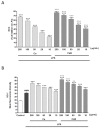Bioavailable Citrus sinensis Extract: Polyphenolic Composition and Biological Activity
- PMID: 28420125
- PMCID: PMC6154582
- DOI: 10.3390/molecules22040623
Bioavailable Citrus sinensis Extract: Polyphenolic Composition and Biological Activity
Abstract
Citrus plants contain large amounts of flavonoids with beneficial effects on human health. In the present study, the antioxidant and anti-inflammatory potential of bioavailable polyphenols from Citrus sinensis was evaluated in vitro and ex vivo, using the murine macrophages cell line J774A.1 and primary peritoneal macrophages. Following simulated gastro-intestinal digestion, the in vitro bioavailability of Citrus sinensis polyphenolic extract was assessed using the human cell line Caco-2 grown as monolayers on a transwell membrane. Data demonstrated a relative permeation of its compounds (8.3%). Thus, the antioxidant and anti-inflammatory effect of polyphenolic Citrus sinensis fraction (Cs) was compared to the bioavailable one (CsB). Results revealed that Citrus extract were able to reduce macrophages pro-inflammatory mediators, including nitric oxide, iNOS, COX-2 and different cytokines. Moreover, the effect of Citrus sinensis polyphenols was associated with antioxidant effects, such as a reduction of reactive oxygen species (ROS) and heme-oxygenase-1 (HO-1) increased expression. Our results provide evidence that the bioavailable polyphenolic constituents of the Citrussinensis extract accumulate prevalently at intestinal level and could reach systemic circulation exerting their effect. The bioavailable fraction showed a higher anti-inflammatory and antioxidant potential compared to the initial extract, thus highlighting its potential nutraceutical value.
Keywords: Citrus sinensis polyphenols; anti-inflammatory; antioxidant; bioavailability; gastro-intestinal digestion.
Conflict of interest statement
The authors declare no competing financial interest.
Figures







Similar articles
-
Polyphenolic Extract from Tarocco (Citrus sinensis L. Osbeck) Clone "Lempso" Exerts Anti-Inflammatory and Antioxidant Effects via NF-kB and Nrf-2 Activation in Murine Macrophages.Nutrients. 2018 Dec 11;10(12):1961. doi: 10.3390/nu10121961. Nutrients. 2018. PMID: 30545010 Free PMC article.
-
Extra virgin olive oil polyphenolic extracts downregulate inflammatory responses in LPS-activated murine peritoneal macrophages suppressing NFκB and MAPK signalling pathways.Food Funct. 2014 Jun;5(6):1270-7. doi: 10.1039/c4fo00014e. Epub 2014 Apr 17. Food Funct. 2014. PMID: 24740524
-
Anti-inflammatory effects of Citrus sinensis L., Citrus paradisi L. and their combinations.Pak J Pharm Sci. 2016 May;29(3):843-52. Pak J Pharm Sci. 2016. PMID: 27166529
-
The influence of polyphenol-rich extracts on the production of pro-inflammatory mediators in macrophages.J Physiol Pharmacol. 2021 Apr;72(2). doi: 10.26402/jpp.2021.2.02. Epub 2021 Aug 6. J Physiol Pharmacol. 2021. PMID: 34374653 Review.
-
Effects of Citrus Fruit Juices and Their Bioactive Components on Inflammation and Immunity: A Narrative Review.Front Immunol. 2021 Jun 24;12:712608. doi: 10.3389/fimmu.2021.712608. eCollection 2021. Front Immunol. 2021. PMID: 34249019 Free PMC article. Review.
Cited by
-
A Novel Vasoactive Peptide "PG1" from Buffalo Ice-Cream Protects from Angiotensin-Evoked High Blood Pressure.Antioxidants (Basel). 2021 Mar 12;10(3):441. doi: 10.3390/antiox10030441. Antioxidants (Basel). 2021. PMID: 33809389 Free PMC article.
-
Blond and blood juice supplementation in high fat diet fed mice: effect on antioxidant status and DDAH/ADMA pathway.RSC Adv. 2019 Apr 11;9(20):11406-11412. doi: 10.1039/c9ra00669a. eCollection 2019 Apr 9. RSC Adv. 2019. PMID: 35520248 Free PMC article.
-
Citrus sinensis and Vitis vinifera Protect Cardiomyocytes from Doxorubicin-Induced Oxidative Stress: Evaluation of Onconutraceutical Potential of Vegetable Smoothies.Antioxidants (Basel). 2020 May 2;9(5):378. doi: 10.3390/antiox9050378. Antioxidants (Basel). 2020. PMID: 32370308 Free PMC article.
-
Nobiletin and Xanthohumol Sensitize Colorectal Cancer Stem Cells to Standard Chemotherapy.Cancers (Basel). 2021 Aug 4;13(16):3927. doi: 10.3390/cancers13163927. Cancers (Basel). 2021. PMID: 34439086 Free PMC article.
-
Quality evaluation of citrus varieties based on phytochemical profiles and nutritional properties.Front Nutr. 2023 May 18;10:1165841. doi: 10.3389/fnut.2023.1165841. eCollection 2023. Front Nutr. 2023. PMID: 37275647 Free PMC article.
References
-
- Hauser A.B., Stinghen A.E., Kato S., Bucharles S., Aita C., Yuzawa Y., Pecoits-Filho R. Characteristics and causes of immune dysfunction related to uremia and dialysis. Perit. Dial. Int. 2008;28:183–187. - PubMed
-
- Pike J., Chandra R.K. Effect of vitamin and trace element supplementation on immune indices in healthy elderly. Int. J. Vitaminol. Nutr. Res. 1995;65:117–121. - PubMed
MeSH terms
Substances
LinkOut - more resources
Full Text Sources
Other Literature Sources
Research Materials

